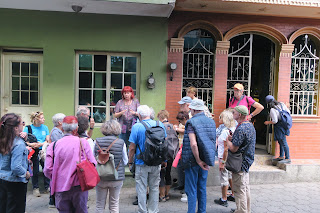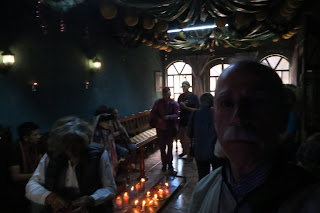Santiago Atitlan (from Nahuatl atitlan, "at the water", in Tz'utujil
Tz'ikin Jaay, "birdhouse") is a municipality in the Sololá department
of Guatemala. The town is situated on Lake Atitlan, which has an elevation of
1,556 metres (5,105 ft). The town sits on a bay of Lake Atitlan between two
volcanoes. Volcán San Pedro rises to 2,846 metres (9,337 ft) west of the town
and Volcan Toliman rises to 3,144 metres (10,315 ft) southeast of the town.
Volcán Atitlan, with an elevation of 3,516 metres (11,535 ft), is
south-southeast of the town. Santiago Atitlan is southwest of Panajachel
across the lake. Major highways reach Lake Atitlan at San Lucas Toliman and
Panajachel. A road links Santiago to San Lucas Tolliman. Boats connect the
numerous communities around the lake.
The majority of the residents are indigenous Maya. It was the capital of the
Tz'utujil people in pre-Columbian times and its name was Chuitinamit.
Santiago Atitlan is the home of the Cojolya Weaving Center and Museum, founded
by the Cojolya Association of Maya Women Weavers. The museum shows the
history, tradition, and process of backstrap-loom weaving, the evolution of
the traditional costume of the Tzutujil, and tells about the indigenous people
of Santiago Atitlan.
Santiago Atitlan was the site of considerable state-sponsored violence during
the country's civil war. Some of the most notable incidents that occurred
during the war include the assassination of Roman Catholic priest Stanley
Rother by right-wing death squads on 28 July 1981, and the massacre of 14
people (and wounding of 21 others) when the Guatemalan Army opened fire on a
crowd of unarmed civilians on 2 December 1990.
|
Taking the ferry.
Taking the ferry from Panajachel towards Santiago Atitlan.
|
|
Sailing on Lake Atitlan.
Lake Atitlan (Spanish: Lago de Atitlan) is a lake in the
Guatemalan Highlands of the Sierra Madre mountain range. The lake is
located in the Sololá Department of southwestern Guatemala. It is known
as the deepest lake in Central America.
-
The lake is surrounded by many villages in which Maya culture is still
prevalent and traditional dress is worn. The Maya people of Atitlan
are predominantly Tz'utujil and Kaqchikel.
|
|
Approaching Santiago Atitlan.
Santiago Atitlan (from Nahuatl atitlan, "at the water", in
Tz'utujil Tz'ikin Jaay, "birdhouse") is a municipality in the
Sololá department of Guatemala. The town is situated on Lake Atitlan,
which has an elevation of 1,556 m (5,105 ft).
-
The town sits on a bay of Lake Atitlan between two volcanoes. Volcán
San Pedro rises to 2,846 metres (9,337 ft) west of the town and Volcan
Toliman rises to 3,144 metres (10,315 ft) southeast of the town.
Volcán Atitlan, with an elevation of 3,516 metres (11,535 ft), is
south-southeast of the town.
-
The majority of the residents are indigenous Maya. It was the capital
of the Tz'utujil people in pre-Columbian times and its name was
Chuitinamit.
|
|
Walking along the Main Street.
The economy is characterized by agriculture and the production and sale
of handicrafts, as well as the commercialization of basic products.
There is also an important hotel sector.
|
|
Visiting a loom weaving shop.
Maya textiles (k’apak) are the clothing and other textile arts of
the Maya peoples, indigenous peoples of the Yucatán Peninsula in Mexico,
Guatemala, Honduras, El Salvador and Belize. Women have traditionally
created textiles in Maya society, and textiles were a significant form
of ancient Maya art and religious beliefs. They were considered a
prestige good that would distinguish the commoners from the elite. Some
of the earliest weaving found in Mesoamerica can date back to around
1000-800 B.C.E.
-
In Mesoamerica, only plant fibers were used before European contact.
The loose fibers are spun into threads by hand, with spindles, a long
stick-like device for holding the thread, and whorls, a weight held on
the spindle to increase its motion.
-
There were two kinds of looms used for weaving, the foot loom and the
back-strap loom.
-
The back-strap loom is almost invariably used by women, who
attach one end of the loom to a tree or post and fix the other end
behind their lower back. For this reason the width of the textile is
constrained by what the particular woman can manage.
-
Until the fairly recent past, foot looms were operated mostly
by men, but this practice is changing.
-
See more at
Maya textiles - Wikipedia.
|
|
Appreciating a Santiago Atitlan huipil.
Many “atitecos”, as the locals are known, still wear traditional
clothing.
-
For women, this historically means huipiles (blouses) embroidered with
flowers and birds paired with a purple-striped skirts. However, the
specific styles are surprisingly trendy, with new patterns and designs
emerging from time to time.
-
Younger men have largely abandoned the old clothing except for
festivals and events but a good portion of the older men still wear
the traditional tops and striped, embroidered pants.
|
|
Being lectured on Tz’utujil language.
Tzʼutujil is a Mayan language spoken by the Tzʼutujil people in the
region to the south of Lake Atitlan in Guatemala.
|
|
Visiting Maximon.
Maximon, also called San Simón, is a Mayan deity and folk saint
represented in various forms by the Maya peoples of several towns in the
Guatemalan Highlands. Oral tradition of his creation and purpose in
these communities is complex, diverse, and born of the ancient Maya
traditions centuries ago.
-
The worship of Maximon is believed to have begun at the time of the
Spanish conquest of the Maya. The designation of Maximon as a saint is
the result of religious syncretism.
-
Maximon's appearance varies greatly by location. While he's popularly
depicted as a man in a suit and hat, this isn't a constant. In
Santiago Atitlan, he wears colorful garlands and scarves, while in
Zunil, he wears sunglasses and a bandana.
-
Maximon is said to represent both light and dark, and to be a
trickster. He is both a womanizer and a protector of couples.
According to some legends, Maximon was an elder who reincarnated to
protect his people.
-
In Santiago Atitlan, a tale says that Maximon was never a man, but a
wooden figure created by shamans to defend the village from witches.
However, Maximon used trickery to harm the people of the village, so
the shamans twisted his head around and broke his legs to stop him. He
then did his job properly and protected the people of the town from
evil.
-
Maximon is venerated in the form of an effigy or cult image. Worship
varies greatly by location. In Santiago Atitlan, Maximon's effigy
resides in a different household every year. His image is normally
only taken out of this house during Holy Week, whereafter it will
change households, but is on display year-round due to the popularity
of pilgrimages. The effigy has special attendants that stay by the
altar year-round, drinking and smoking alongside it. They deliver
offerings from the public to the image. Popular offerings include
money, tobacco, and moonshine.
-
See more at
Maximón - Wikipedia.
|
|
The Body of the Dead Christ in the Tomb.
Inside Maximon's chapel is a statue of the dead body of Christ displayed
laid out on a funeral bier.
-
The state of the dead Christ is the mystery of the tomb and the
descent into hell. It is the mystery of Holy Saturday, when Christ,
lying in the tomb, reveals God's great sabbath rest after the
fulfilment of man's salvation.
-
Christ's stay in the tomb constitutes the real link between his
passible state before Easter and his glorious and risen state today.
-
See more at
Burial of Jesus - Wikipedia
and
Tomb of Jesus - Wikipedia.
|
|
The Catholic saints.
In a room next to Maximon's chapel are the Catholic saints.
-
The patron saint of Santiago Atitlan is
Saint James (Santiago). In the Catholic tradition, Saint
James is the patron saint of Spain and, according to legend, his
remains are held in Santiago de Compostela in Galicia. The traditional
pilgrimage to the grave of the saint, known as the "Way of St. James",
has been the most popular pilgrimage for Western European Catholics
from the Early Middle Ages onwards.
-
Maximon is also called Saint Simon (San Simon). Saint
Simon is perhaps the most unknown of the apostles. When Saint Luke, in
his Gospel, calls him "the Zealot", he seems to mean that Simon
belonged to the radical Jewish party that bore the same name. Zealot
radicals preached armed struggle against the rulers. It is known that
Simon, like all the other apostles of the early days of Christianity,
after Pentecost traveled the streets preaching the Gospel without
taking anything with him. He performed many miracles, cured the sick,
cleansed lepers, and cast out evil spirits.
-
In later tradition, Saint Simon is often associated with
Saint Jude the Apostle as an evangelizing team; in Western
Christianity, they share their feast day on 28 October. Both are the
patron saints of desperate situations, forgotten causes, hospital
workers, hospitals, impossible causes and lost causes.
-
See more at
James the Great - Wikipedia,
Simon the Zealot - Wikipedia
and
Jude the Apostle - Wikipedia.
|
|
Visiting the church of Saint James the Apostle.
This was the first Catholic church built by the Spanish at Lake Atitlan
(in the 1540s). The church is built on a Maya temple site.
-
There’s still an interesting mixture of Maya gods inside the church.
-
Along the walls of the church are wooden statues of the saints, each
of whom has new clothes made by local women every year.
-
At the front stand three colonial altarpieces that were renovated
between 1976 and 1981 by brothers Diego Chávez Petzey and Nicolás
Chávez Sojuel. These symbolize the three volcanoes around Santiago,
which are believed to protect the town. The central one was subtly
changed from a traditional European vision of heaven to a more Maya
representation of a sacred mountain with two cofradía members climbing
toward a sacred cave.
-
There’s a shrine to priest Stanley Francis Rother – the American
priest from Oklahoma, who was one of the 10 priests to be killed in
Guatemala in 1981 during the brutal civil war.
|
|
Wrapping the hair belt.
The Tzutujil xk'op (commonly called a "tocoyal" in the rest of
Guatemala) is a colorful belt that must be a good twenty meters long. It
is wrapped around a woman's head and looks like a very thick brimmed hat
with no crown.
-
The head belt (xk'op) from Santiago has been immortalized on
the
choka, the Guatemalan 25 cent piece.
-
It is only worn now by some older women, on special occasions. Most
younger people preferthread simpler barrettes, either Chinese plastic
ones brought from the capital or, especially more recently, beaded
ones.
-
Early belts (cintas) were much smaller (narrower and shorter)
than modern-day ones, hanging out about 3 cm (1 in) from the head.
They were unpatterned, mainly green, magenta, orange and purple with a
red central section, woven of cotton or, for rich people, a shiny
rayon or silk.
-
Gradually they became wider and longer (hanging out further) and began
to be decorated with tapestry designs, more or less in the same
colors, ultimately resulting in the modern hair wrap, a beautiful
disc-like saucer affair, slanted upwards, that hangs some 10 to 11 cm
(4 to 5 in) from the head.
|
See also
Source
Location













































